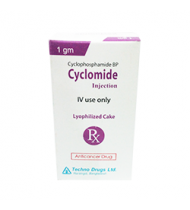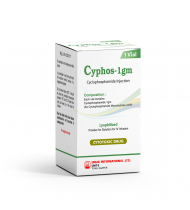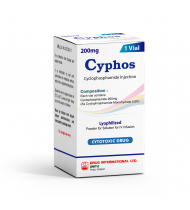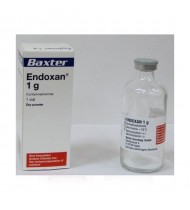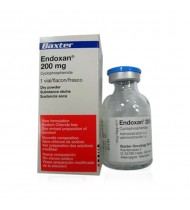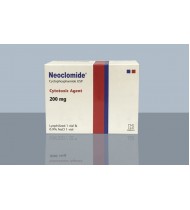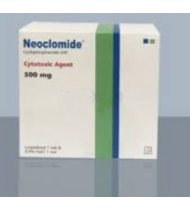Cyclophosphamide
Indications
Malignant Diseases:
Cyclophosphamide is indicated for the treatment of:- Malignant lymphomas (Stages III and IV of the Ann Arbor staging system), Hodgkin's disease, lymphocytic lymphoma (nodular or diffuse), mixed-cell type lymphoma, histiocytic lymphoma, Burkitt's lymphoma
- Multiple myeloma
- Leukemias: chronic lymphocytic leukemia, chronic granulocytic leukemia (it is usually ineffective in acute blastic crisis), acute myelogenousand monocytic leukemia, acute lymphoblastic (stem-cell) leukemia (cyclophosphamide given during remission is effective in prolonging its duration)
- Mycosis fungoides (advanced disease)
- Neuroblastoma (disseminated disease)
- Adenocarcinoma of the ovary
- Retinoblastoma
- Carcinoma of the breast
Minimal Change Nephrotic Syndrome in Pediatric Patients:
Cyclophosphamide is indicated for the treatment of biopsy proven minimal change nephrotic syndrome in pediatrics patients who failed to adequately respond to or are unable to tolerate adrenocorticosteroid therapy.Pharmacology
Dosage
Intravenous (Adult)-
Malignancies:- Low dose regimen: 2-6 mg/kg wkly as a single dose;
- Moderate dose regimen: 10-15 mg/kg wkly as a single dose;
- High dose regimen: 20-40 mg/kg as a single dose every 10-20 days.
- 80-300 mg/m2 daily as a single dose, or
- 300-600 mg/m2 wkly as a single dose, or
- 600-1,500 mg/m2 as a single dose or
- Short infusion at 10- to 20-day intervals.
Oral (Child)-
Nephrotic syndrome:- 2 mg/kg daily for 8-12 wk.
- Max cumulative dose: 168 mg/kg.
- Max duration: 90 days.
Oral (Adult)-
Malignancies:- Low dose regimen: 2-6 mg/kg wkly in divided dose.
- Alternatively, 100-300 mg daily in divided doses, or
- 50-250 mg/m2 daily or 80-300 mg/m2 daily in divided doses.
Administration
Interaction
Contraindications
Side Effects
Pregnancy & Lactation
Precautions & Warnings
Overdose Effects
Management: Supportive treatment. May consider haemodialysis. Cystitis prophylaxis with mesna may be useful for urotoxicity.
Therapeutic Class
Reconstitution
Storage Conditions
Cyclomide IV Infusion 1 gm/vial
IndicationsMalignant Diseases:Cyclophosphamide is indicated for the treatment of:Malignant lymp..
700.00Tk.
Cyclomide IV Infusion 200 mg/vial
IndicationsMalignant Diseases:Cyclophosphamide is indicated for the treatment of:Malignant lymp..
150.00Tk.
Cyclotox IV Infusion 1 gm/vial
IndicationsMalignant Diseases:Cyclophosphamide is indicated for the treatment of:Malignant lymp..
650.00Tk.
Cyclotox IV Infusion 200 mg/vial
IndicationsMalignant Diseases:Cyclophosphamide is indicated for the treatment of:Malignant lymp..
180.00Tk.
Cyphos IV Infusion 1 gm vial
IndicationsMalignant Diseases:Cyclophosphamide is indicated for the treatment of:Malignant lymp..
600.00Tk.
Cyphos IV Infusion 200 mg vial
IndicationsMalignant Diseases:Cyclophosphamide is indicated for the treatment of:Malignant lymp..
150.00Tk.
Endoxan IV Infusion 1 gm vial
IndicationsMalignant Diseases:Cyclophosphamide is indicated for the treatment of:Malignant lymp..
982.38Tk.
Endoxan IV Infusion 200 mg vial
IndicationsMalignant Diseases:Cyclophosphamide is indicated for the treatment of:Malignant lymp..
222.63Tk.
Endoxan IV Infusion 500 mg vial
IndicationsMalignant Diseases:Cyclophosphamide is indicated for the treatment of:Malignant lymp..
521.76Tk.
Endoxan Tablet 50 mg
IndicationsMalignant Diseases:Cyclophosphamide is indicated for the treatment of:Malignant lymp..
34.36Tk.
Neoclomide IV Infusion 1 gm vial
IndicationsMalignant Diseases:Cyclophosphamide is indicated for the treatment of:Malignant lymp..
800.00Tk.
Neoclomide IV Infusion 200 mg vial
IndicationsMalignant Diseases:Cyclophosphamide is indicated for the treatment of:Malignant lymp..
197.00Tk.
Neoclomide IV Infusion 500 mg vial
IndicationsMalignant Diseases:Cyclophosphamide is indicated for the treatment of:Malignant lymp..
464.00Tk.
Neoclomide Tablet 50 mg
IndicationsMalignant Diseases:Cyclophosphamide is indicated for the treatment of:Malignant lymp..
31.00Tk.

